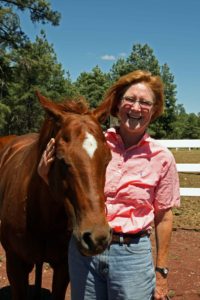![]() November 2009
November 2009
 The gravel driveway leading to Valerie Hannemann’s home and office in the woods passes a horse pen. The licensed psychologist and Northern Arizona University professor, dressed in boots and jeans with a red and white checkered shirt, stands within the fenced area, calling one of her three horses. The spirited animal comes close and shoots off again.
The gravel driveway leading to Valerie Hannemann’s home and office in the woods passes a horse pen. The licensed psychologist and Northern Arizona University professor, dressed in boots and jeans with a red and white checkered shirt, stands within the fenced area, calling one of her three horses. The spirited animal comes close and shoots off again.
She laughs. He is reluctant, but she means to catch him. Serious then, Hannemann commands the horse several times, and it eventually accepts the halter. The horse trusts and responds to her respectful direction. “Horses are flight animals, so are built to pick up everything in their surroundings and reflect what is happening,” she said. This is what makes them valuable in the symbiosis of therapy.
“I don’t use it (Equine Assisted Therapy) with everybody,” Hannemann said. “If it’s difficult to talk, I can say, ‘Let’s just go out and mess with the horses awhile.’ I’ve had some amazing breakthroughs that way. Even cleaning out the stall – a great thinking place, by the way – can work. And smells have such strong power, too.”
A certified therapist helps a client to establish a relationship with the horse through grooming, walking, and sometimes, riding. Noise, aggression and disrespect hinder that connection, and often, a person’s inconsistencies, boundaries, feelings and problems surface. In short, the client asks for trust from the horse which inspires trust in the client. Autism, Bi-Polar Disorder, Attention Deficit Disorder as well as anti-social behaviors benefit from grasping the calming interactions necessary to work with a horse. Their successes increase self-esteem.
In 2002, Hannemann became interested in combining her love and ownership of horses with her career, so she certified through the Equestrian Assisted Growth and Learning Association, a non-profit group founded in 1999. With her home in one place, an office downtown and her horses and arena in a third, she completed the transition by merging her locations and purpose as well.
Equine Assisted Therapy (EAT) originated in Germany as therapeutic riding for people with physical deformities. “It is used a tremendous amount with children who are physically handicapped or developmentally delayed,” Hannemann explained. “On a horse, the physically disabled becomes mobile and bigger than anything else. You see a change in demeanor from quiet, head down to popping up with excitement.”
It was an easy leap to apply EAT to psychological disorders, even severe ones. Hannemann encourages people to problem-solve by engaging her horses. “Hindered adolescents, couples, families or corporate teams performing exercises with horses reveal the dynamics of people working together. Whether it’s family or colleagues, people forget who they are in the confines of that exercise and can recognize valuable resources in individuals.”
The animals create awareness and insight by teaching people about themselves. Hannemann identifies two basic emotions – fear and love – and suggests that when people are pushed beyond their comfort zones, their coping skills in handling those two feelings emerge. “Horses don’t lie; they have no reason to. Horses are wonderful for getting people into their stuff, working through their issues in the quickest, most effective ways possible,” she said.
A woman in her 20’s came to Hannemann. Bound up by a past she had never divulged, she had trouble talking, so the therapist suggested they go out to the horses. The woman complained that she didn’t know anything about horses. Telling the story, Hannemann said, “That’s OK. I handed her a halter and asked her to go catch a horse and bring it back. ‘How?’ she said. It doesn’t matter. ‘Which one?’ Doesn’t matter. She tried for ten minutes, and the horses didn’t allow it. Ten minutes more and the anger, frustration and uncertainty came out in her. She said, ‘Why don’t they like me? What’s wrong?’”
Hannemann caught a horse, and they began to groom the animal that day and over the next sessions. The woman began to talk about her abusive family situation. Eventually, the psychologist sat the woman on her steady steed, Cowboy, and walked alongside. “There is something magical about being on a horse. Now, she’s bigger, taller…It gave her a shift in perspective. It turned the woman around 180 degrees. She got married, got a job and made a great transition.”
Hanneman gives her horses credit. “Cowboy facilitated that. I couldn’t have done it on my own.” And she understands a horse’s significance in dealing with men, especially those with Post-Traumatic Stress Disorder involved with the armed forces or police work or emergency response. These men tend to talk in superficial means, yet, because of their experiences, can be suffering.
“Interacting with this big warm thing…creates a safer place to talk. These men already feel responsible – that they are a reprehensible monster – and are afraid if those they love find out (what they’ve done), they will feel they are a reprehensible monster, too and leave them,” she says. Military personnel also worry about records exposing their mental health. “Because of the horse’s size, people project their stuff onto the animal. Men respond to the horse responding to them. It’s affirmation. Meaningful experience in the moment, so instant benefit.” NAMLM
Gail G. Collins
